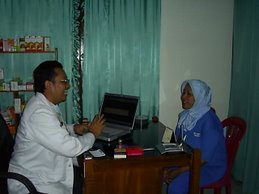
DRUG CLASS AND MECHANISM:
Glimepiride is an oral blood sugar-lowering drug in a class of medicines for controlling diabetes called sulfonylureas. Glimepiride is related to other sulfonylureas including glyburide (Micronase; Diabeta), glipizide (Glucotrol), tolbutamide (Orinase) and tolazamide (Tolinase).
Glimepiride is used in type II diabetes, the most common type of diabetes that is found in 90% of patients with diabetes. In type II diabetes, insulin usually is not necessary to control the blood sugar. Instead, diet and oral medications often are sufficient. Intolerance to sugar that results in elevated blood sugar is caused by reduced insulin secretion by the pancreas and resistance to insulin's effects by the body's cells. Glimepiride lowers the sugar level in the blood by stimulating insulin to be secreted from the pancreas into the blood. Insulin causes sugar to leave the blood and enter cells throughout the body.
Glimepiride is used in type II diabetes, the most common type of diabetes that is found in 90% of patients with diabetes. In type II diabetes, insulin usually is not necessary to control the blood sugar. Instead, diet and oral medications often are sufficient. Intolerance to sugar that results in elevated blood sugar is caused by reduced insulin secretion by the pancreas and resistance to insulin's effects by the body's cells. Glimepiride lowers the sugar level in the blood by stimulating insulin to be secreted from the pancreas into the blood. Insulin causes sugar to leave the blood and enter cells throughout the body.
Glimepiride was approved by the FDA in December of 1995.
GENERIC AVAILABLE: yes
PRESCRIPTION: yes
PREPARATIONS: Tablets: 1mg, 2mg, 4mg.
STORAGE: Tablets should be stored below 86°F (30°C).
PRESCRIBED FOR:
It is believed that control of blood sugar in diabetics decreases the risks of eye, kidney, and nerve damage. Glimepiride is used to treat type II diabetes that cannot be controlled by a strict diabetic diet alone. If sulfonylureas are not effective, other oral drugs or insulin may be used.
DOSING:
Like other medicines used to treat diabetes, the dose of glimepiride is individualized using periodic measurements of blood sugar to determine the best dose.
DRUG INTERACTIONS:
Medicines that can increase blood sugar can reverse the action of glimepiride. These drugs include diuretics [e.g. hydrochlorothiazide, furosemide (Lasix)], corticosteroids such as prednisone and methylprednisolone (Medrol)], phenytoin (Dilantin), niacin, and sympathomimetics such as pseudoephedrine (Sudafed).
Beta-blockers such as propranolol (Inderal) and atenolol (Tenormin) can cause low or high blood sugar. Additionally, they can directly reverse the sugar-lowering effect of sulfonylureas and render them less effective. Beta-blockers also can blunt some of the body's protective responses to low blood sugar, thus making it difficult for patients to recognize reactions due to low blood sugar. This notwithstanding, beta-blockers have been used successfully in diabetic patients and have been associated with improved survival in diabetics with high blood pressure.
Rifampin increases the breakdown of two other sulfonylureas, tolbutamide (Orinase) and glyburide (Diabeta, Micronase). This might interfere with the effects of the drugs and result in higher levels of sugar in the blood. Although this same interference has not yet been reported with glimepiride, the possibility that it may occur should be kept in mind.
Beta-blockers such as propranolol (Inderal) and atenolol (Tenormin) can cause low or high blood sugar. Additionally, they can directly reverse the sugar-lowering effect of sulfonylureas and render them less effective. Beta-blockers also can blunt some of the body's protective responses to low blood sugar, thus making it difficult for patients to recognize reactions due to low blood sugar. This notwithstanding, beta-blockers have been used successfully in diabetic patients and have been associated with improved survival in diabetics with high blood pressure.
Rifampin increases the breakdown of two other sulfonylureas, tolbutamide (Orinase) and glyburide (Diabeta, Micronase). This might interfere with the effects of the drugs and result in higher levels of sugar in the blood. Although this same interference has not yet been reported with glimepiride, the possibility that it may occur should be kept in mind.
PREGNANCY:
In animal studies, glimepiride and other sulfonylureas have been associated with a higher risk of fetal death. However, there have been no good studies in women. On the other hand, abnormal blood sugar concentrations (high or low) during pregnancy increase the risk of abnormalities in the fetus. Therefore, physicians must carefully weigh the benefits and risks of sulfonylurea treatment during pregnancy.
NURSING MOTHERS:
It is not known if glimepiride is excreted in breast milk like other sulfonylureas. Because of the risk of low blood sugar in the infant, it is recommended that glimepiride be discontinued in nursing mothers. If therapy other than diet and exercise is needed, insulin is recommended.
SIDE EFFECTS:
Low blood sugar can occur during glimepiride therapy. Symptoms of low blood sugar include hunger, nausea, tiredness, perspiration, headache, heart palpitations, numbness around the mouth, tingling in the fingers, tremors, muscle weakness, blurred vision, cold temperature, excessive yawning, irritability, confusion, or loss of consciousness. Other side effects include dizziness (1 of every 60 persons), headache (1 of every 75), and nausea or vomiting (1 of every 90). A rash occurs in fewer than 1 of every 100 persons who receive glimepiride.

